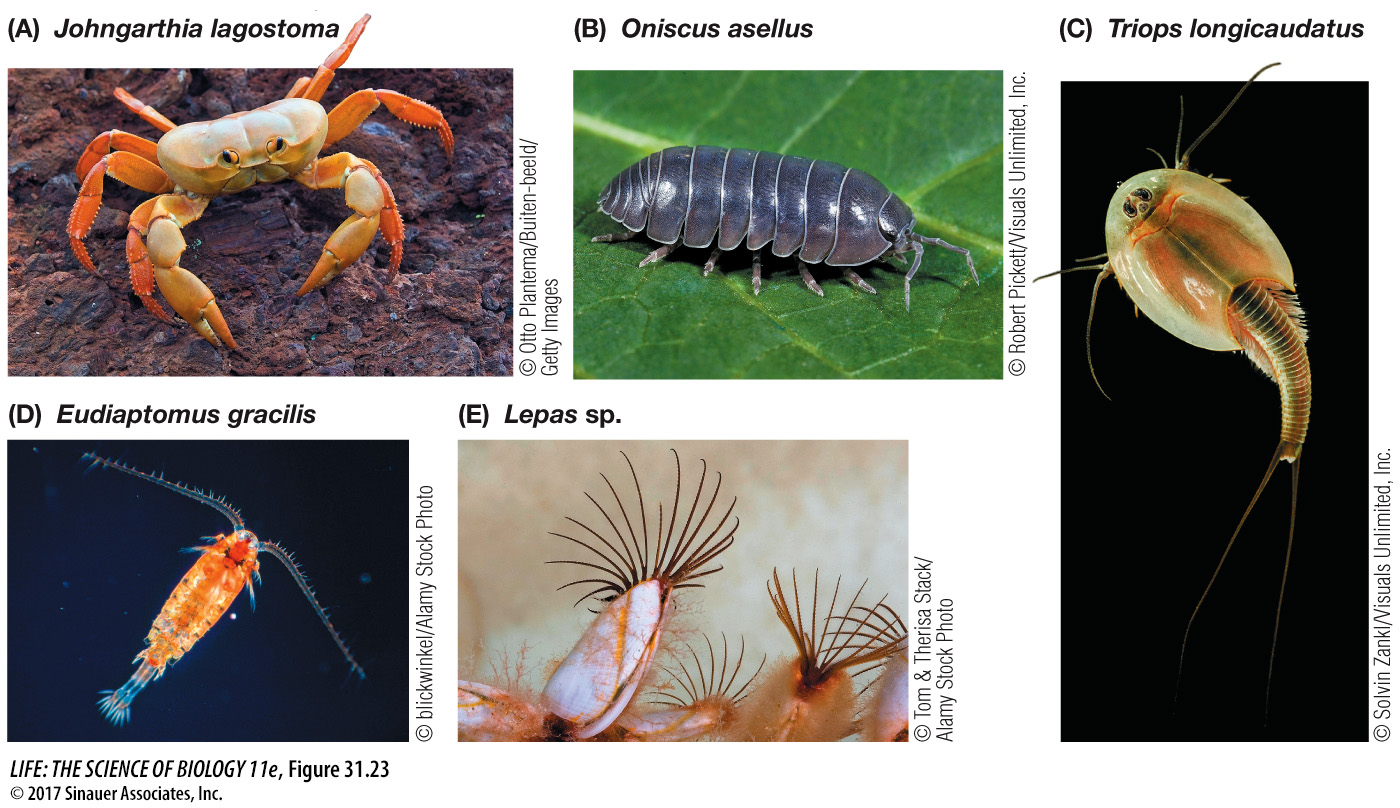Mandibles and antennae characterize the remaining arthropod groups
The remaining three arthropod groups—the myriapods, crustaceans, and hexapods—have mouthparts that are mandibles, rather than chelicerae, so they are collectively called mandibulates. Mandibles can be used for chewing as well as for biting and holding food. Another distinctive characteristic of the mandibulates is the presence of sensory antennae on the head.
MYRIAPODS The myriapods comprise the centipedes, millipedes, and their close relatives. Centipedes and millipedes have a well-formed head that bears the mandibles and antennae characteristic of mandibulates. Their distinguishing feature is a long, flexible, segmented trunk that bears many pairs of legs. Centipedes, which have one pair of legs per segment (Figure 31.22A), prey on insects and other small animals. In millipedes, two adjacent segments are fused so that each fused segment has two pairs of legs (Figure 31.22B). Millipedes scavenge and eat plants. More than 3,000 species of centipedes and 9,000 species of millipedes have been described; many more species probably remain unknown. Although most myriapods are less than a few centimeters long, some tropical species are ten times that size.

Figure 31.22 Myriapods (A) Centipedes have modified appendages that function as poisonous fangs for capturing active prey. They have one pair of legs per segment. (B) Millipedes are scavengers and plant eaters; they have smaller jaws and legs than centipedes do, and they have two pairs of legs per segment.
CRUSTACEANS Crustaceans are the dominant marine arthropods today, and they are also common in fresh water and some terrestrial environments. The most familiar crustaceans are the shrimps, lobsters, crayfishes, and crabs (all decapods; Figure 31.23A) and the sow bugs (isopods; Figure 31.23B). Additional species-rich groups include the amphipods, ostracods, branchiopods (Figure 31.23C), and copepods (Figure 31.23D), all of which are found in freshwater and marine environments.

Figure 31.23 Crustacean Diversity (A) This decapod crustacean, a land crab, is found only on four islands in the South Atlantic Ocean. (B) This pillbug, a terrestrial isopod, can roll into a tight ball when threatened. (C) This tadpole shrimp, a branchiopod, is common in seasonal pools of the southwestern United States. (D) This minute copepod is found in freshwater lakes throughout Europe. (E) Gooseneck barnacles attach to a substrate by their muscular stalks and feed by protruding and retracting their feeding appendages.
Barnacles are unusual crustaceans that are sessile as adults (Figure 31.23E). Adult barnacles look more like mollusks than like other crustaceans, but as the zoologist Louis Agassiz remarked more than a century ago, a barnacle is “nothing more than a little shrimp-like animal, standing on its head in a limestone house and kicking food into its mouth.”
Media Clip 31.7 Barnacles Feeding
Most of the 67,000 described species of crustaceans have a body that is divided into three regions: head, thorax, and abdomen (Figure 31.24). The segments of the head are fused together, and the head bears five pairs of appendages. Each of the multiple thoracic and abdominal segments usually bears one pair of appendages. The appendages on different parts of the body are specialized for different functions, such as gas exchange, chewing, capturing food, sensing, walking, and swimming. In many species, a fold of the exoskeleton, the carapace, extends dorsally and laterally back from the head to cover and protect some of the other segments.

Figure 31.24 Crustacean Body Plan The bodies of crustaceans are divided into three regions: the head, thorax, and abdomen. Each body region bears specialized appendages. A shell-like carapace covers the head and thorax.
Question
Q: In what ways is the crustacean body plan similar to and different from the insect body plan shown in Figure 31.26?
Both are three-part body plans, divided into head, thorax, and abdomen. Both crustaceans and insects have antennae and feeding appendages on the head. However, crustaceans have additional appendages growing from both the thorax and the abdomen, whereas in insects, additional appendages are limited to the thorax. In addition, crustaceans have more than three pairs of limbs on the thorax, whereas insects have three pairs of limbs on the thorax and, in most groups, two pairs of wings.
The fertilized eggs of most crustacean species are attached to the outside of the female’s body, where they remain during their early development (see Figure 31.23D). At hatching, the young of some species are released as larvae; those of other species are released as juveniles that are similar in form to the adults. Still other species release eggs into the water or attach them to an object in the environment.


